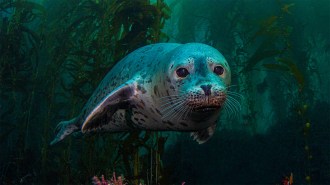Quick Fix: How invasive seaweed repairs its wounds
- More than 2 years ago
Rapid self-healing is critical to the invasiveness of an alien green alga that’s currently wreaking havoc in the Mediterranean Sea. Now, scientists have discerned the chemistry underlying this highly efficient repair process. That understanding may provide ideas for thwarting the seaweed’s relentless spread.

Frequently referred to as the “killer alga,” Caulerpa taxifolia is a bright-green, tropical seaweed with fernlike fronds. Each organism is a single cell that can reach several meters in length and contains many copies of its genetic material.
In the 1980s, an aquarium in Stuttgart, Germany, created an aquarium-friendly C. taxifolia strain that is fast growing and cold tolerant. The strain escaped into the environment and has spread throughout the Mediterranean from Spain to Croatia, where it has wiped out thousands of acres of sea grass beds and other native vegetation (SN: 7/4/98, p. 8: http://www.sciencenews.org/pages/sn_arc98/7_4_98/bob1.htm).
Small patches of the aquarium strain have also appeared off the coasts of California and Australia. Although officials have nearly eradicated the seaweed in California at a cost of several million dollars, efforts to remove its vast carpets from the Mediterranean have failed.
At the heart of the seaweed’s widespread proliferation is its capacity to quickly repair damage to its cell membranes. For instance, when a cell gets broken into multiple pieces, the resulting fragments seal themselves off in a matter of seconds and establish new colonies.
“The spread of this clone is completely dependent on its ability to spread by fragmentation,” says marine biologist Andrew Cohen of the San Francisco Estuary Institute in Oakland, Calif. “Even very tiny pieces of it can regrow.”
To shed light on the healing mechanism, Georg Pohnert and his colleagues of the Max Planck Institute for Chemical Ecology in Jena, Germany, compared the chemical makeup of intact and wounded samples of the aquarium strain. The researchers found that after injury, the seaweed produces an enzyme that transforms a compound called caulerpenyne—a by-product of the cell’s metabolism—into a highly reactive chemical.
The cell recruits algal proteins to the site of injury, and the reactive chemical, called oxytoxin, links them into a tough polymer network within seconds after an injury. This network forms a sticky plug that prevents the cell’s contents from spilling into the seawater, the researchers report in the April 29 issue of Angewandte Chemie International Edition.
Pohnert says that his group plans to use the findings to develop inexpensive, nontoxic compounds that would block the plugging process. Although it might be too late to treat the Mediterranean algal colonies, he says, such inhibitors could work well for attacking small, newly discovered patches.
His group is also interested in designing superglues that mimic the biochemical reactions in seaweed wound healing.






